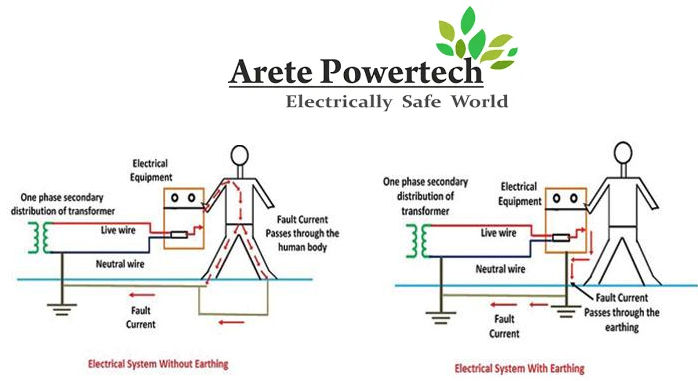Earthing Test
Earthing Value Testing, also known as Earth Resistance Testing or Grounding Testing, is a procedure used to measure the resistance of the earth electrode to the flow of electric current. It ensures that the grounding system effectively dissipates fault currents, preventing electrical hazards and ensuring safety in electrical installations.
Why Do We Need Earthing

Effective earthing is essential for the safe operation of every electrical system and the only way to ensure that earthing installations are effective and that they remain so, is to test them rigorously and regularly.
What is Earth Resistance?
The resistance of the earth electrode to the current flow into the earth is known as earth resistance. The resistance between the earth and the earthing plate is measured through a potential fall method.
Numerically, it is equivalent to the ratio of the earth electrode potential to the current disappeared by it. The resistance between the earthing plate and the earth is assessed through the potential fall method.
The earthing resistance value is based upon the soil resistivity, construction design, and climate-related conditions. Moisture in soil plays a critical role in the resistivity of the soil. Different types of codes indicate the desired value of an earthing system.
Why Should We Measure Earth Resistance
Safety: Measuring earth resistance helps find and mitigate potential electrical hazards, such as electric shock and fires. It ensures that the earth electrode system can effectively dissipate fault currents, preventing the buildup of dangerous voltages and protecting individuals and equipment.


How Frequently We Should Measure Earth Resistance
It typically involves checks of the presence, appropriate redundancy, suitability and visible condition of earthing conductors, connections, surface layer materials and connected equipment and is typically recommended at intervals of between 1 and 3 years.
What Is The Acceptable Earth Resistance Value In India
The acceptable earthing resistance value in India is as follows: –
| (1) Earth Resistance of Power Station | 0.5 ohms |
| (2) Earth Resistance of EHT Sub-station | 1.0 ohms |
| (3) Earth Resistance of 33 KV Stations | 2.0 ohms |
| (4) Earth Resistance of D/t Structure | 5.0 ohms |
| (5) Tower Foot Resistance | 10.0 ohms |
About Arete Powertech:
Established in 2008, Arete Powertech has been at the forefront of revolutionizing Electrical Safety and energy-efficient solutions. Our dedication to maintaining international standards and our unwavering commitment to customer satisfaction have earned us a distinguished reputation in the field.
Our Products:
Best Chemical Earthing Solution, Copper Chemical Earthing Electrodes, Copper Bonded Earthing Electrode, GI Chemical Earthing Rod, Maintenance free Copper Bonded Electrodes.
Why Choose Arete Powertech
- Expertise: With years of experience and expertise in the field, our technicians possess the necessary skills to diagnose and repair a wide range of Earthing and Lightning Arrester system.
- Customized Solutions: We recognize that each client’s needs are unique. Therefore, we tailor our repair services to accommodate the specific requirements of your Earthing and Lightning Arrester system.
- Quality Assurance: At Arete Powertech, quality is paramount. We adhere to the highest standards of excellence in every repair job we undertake, ensuring that your modules operate at peak efficiency.
- Timely Service: We understand the importance of minimizing downtime. Our efficient repair process ensures that your SMPS Rectifier Modules are back in operation in the shortest possible time frame.

